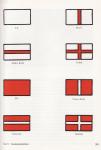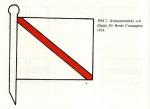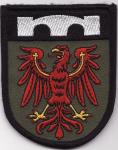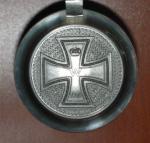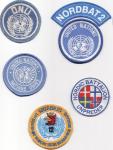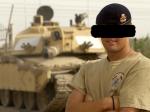-
Posts
432 -
Joined
-
Last visited
-
Days Won
1
Content Type
Profiles
Forums
Blogs
Gallery
Events
Store
Everything posted by GRA
-
The old company insignia around 1900, 1st battalion white (1st-4th companies), 2nd battalion red (5th-8th companies). 4th and 5th companies later changed colours with each other, and Lifkompaniet - the colonel's own company - added the letters "Lif" to their company flag, those letters made a comeback on the second design of patches. 1st Coy Lifkompaniet 2nd Coy Marks kompani 3rd Coy Södra Kinds kompani 4th Coy Vedens kompani 5th Coy Åhs kompani 6th Coy Norra Kinds kompani 7th Coy Gäseneds kompani 8th Coy Redvägs kompani When the regiment moved into Borås and their newly built barracks, a new company flag saw the light of day - Borås kompani. Note the difference in design from the older flags.
-
The habit of using company insignia in the Swedish Army dates back to the 1830's, then used as a cap badge, but later also as flags (not to be confused with the company colours of the 17th-18th centuries). In the early 1980's unit patches were allowed on field uniform, some units chose not only a regimental patch, but also company patches, the Älvsborg Regiment (15th Infantry Regiment) kept to the tradition of the company insignia of old. There were two different designs; The first, more colourful and adhering to the colours of the old company insignia, was worn from 1982 as a cheap plastic variant, and as an embroidered cloth patch (at first only for officers, it was later issued to the conscript soldiers too) from 1984, and the second, the more heraldic-influenced design, from early 1995 until the regiment disbanded in 1998. Regimental HQ insignia /Jonas
-

Bundesrepublik Pionierbrigade 80
GRA replied to GRA's topic in Germany: Post 1945: Bundesrepublik & DDR
Hello Daniel! Thank you, they are memories of a good friend who died way too early back in 2006. I got this mug from him around 2000 after he got assigned to the brigade, and if I recall correctly he was promoted to Hauptmann d R in that unit (he might have made Major d R too, but we lost contact due to him getting ill and subsequently dying), I'm not sure if he was ever assigned to one of the battalions. I have no idea where the brigade HQ was stationed. Neubrandenburg? /Jonas -
Hello John! The first rotation (BA01) had three Swedish mech inf companies as well as the Danish tank squadron, the fourth mech inf coy was introduced with the second rotation (BA02), there was also a HQ Coy. The Danish tank squadron seem to have disappeared with the changeover between BA04 and BA05. The battalion changed name (and master) during the fifth rotation to Swebat, when NATO took over (BA05-BA07 IFOR, BA07-BA99 SFOR). /Jonas
-

Bundesrepublik Pionierbrigade 80
GRA replied to GRA's topic in Germany: Post 1945: Bundesrepublik & DDR
-

Bundesrepublik Pionierbrigade 80
GRA replied to GRA's topic in Germany: Post 1945: Bundesrepublik & DDR
-
Beer mug from the now disbanded PiBrig80 (the brigade itself is disbanded, but there could well be a surviving battalion left somewhere in the Bundeswehr order of battle), as I recall, the friend (a Hauptmann d R assigned to the brigade) who gave this mug to me also had another one with a slightly different motif - the bridge being black on a white background, which may have been designating a sub-unit (HQ Coy?). /Jonas Edit: Having searched the internet as well as given the old brain some exercise, I'm fairly certain that the mug insignia as well as the patch are of the brigade HQ Coy, and that the brigade insignia had the black bridge on white background.
-
Some patches with a Scandinavian connection: Starting with a patch worn by a Swede in the ONUC mission in Congo pre-1963 (the veteran I got it from were awarded the medal with the UNTSO-style ribbon with a "Congo" clasp, not the later green-white-blue ribbon). Then over to the ex-Yugoslavia missions of the 90's, the Nordbat 2 combination was worn by the Swedish contribution to UNPROFOR (it also included a Danish tank squadron), the UNPREDEP patch was issued to a Dane in the Scandinavian mission in Macedonia (which was actually considered the original Nordbat, hence Nordbat 2 in Bosnia). The Shirbrig patch has a Swedish connection because of the griffin (the regimental insignia of the South Scanian Regiment), and if Sweden didn't actually contribute with troops to Shirbrig, it could very well have been training in Southern Sweden. The bilingual UN patch is also Swedish in origin, but normally the patch with United Nations in English would be issued. /Jonas
-

EK 1914 Super Bombastic EK Docs....
GRA replied to Chris Boonzaier's topic in Germany: All Eras: The Iron Cross
Some royal visit in either direction? Medals and orders tended to rain down on those involved. A German receiving a Swedish medal for gallantry (Tapperhet i fält) would be a tall order, but on the other hand, a Swede temporarily serving in a German unit (for example) during WW1 could very well be decorated with a Swedish gallantry medal despite the fact that Sweden were at the time strictly neutral and a non-combattant nation. An Order of the Sword wouldn't require combat service (or at least not involving gallantry), so I think it could be awarded in connection with, let's say, a royal visit. /Jonas -

EK 1914 Super Bombastic EK Docs....
GRA replied to Chris Boonzaier's topic in Germany: All Eras: The Iron Cross
-
Hello Christer! Line infantry (or the Guards) by the look of the sabre pattern, and they brought at least one officer with them (the captain in the middle of the front row). Any idea which unit, or could it be a SNCO school "on tour"? Or could it be a German visit to Sweden even? It seems a bit unlikely to send a group of NCOs to another country at war, as far as I know, the Swedes participating on either side in WW1 did it as individuals (but then again, visiting and participating are two totally different activities). /Jonas
-
Thanks Hugh! As I mentioned, I'm no oracle at this, and some of the deeper details as to entitlement to a ribbon device are still fuzzy to me. One learns something new each day in this hobby! /Jonas
-

Lancer Skulls Query
GRA replied to Robin Lumsden's topic in Great Britain: Militaria: Badges, Uniforms & Equipment
Makes sense, I never experienced it myself though, since I never served on armoured vehicles (and personal headsets for troopers on foot didn't exist in the Swedish army back in my time). /Jonas -
Hello Ulsterman! Wouldn't there be some campaign stars / arrowheads or some such on the European Campaign ribbon? I assume that the colonel ought to have at least a campaign star or two, since he also got a Bronze Star, which I believe is awarded for "hands-on service" and not for mere paper pushing at HQ. Which is the correct order of wear for the pre-1941 service, US service and the various campaign medals? What are the two ribbons missing (I assume his ribbon bar is a "2-3-3")? /Jonas
-

Lancer Skulls Query
GRA replied to Robin Lumsden's topic in Great Britain: Militaria: Badges, Uniforms & Equipment
Hello Dave! I fully agree, we did the same in my regiment, somehow beret badges tends to crawl towards the ear at the same rate as the regulations gets older... On the other hand, I've on occasion seen beret badges (including mottoes!) worn bang in the middle of the forehead too. /Jonas -

Lancer Skulls Query
GRA replied to Robin Lumsden's topic in Great Britain: Militaria: Badges, Uniforms & Equipment
-
Hello Christer! If someone knows when the Victory medal and the Army of Occupation Medal were first issued, you might be able to get an earliest date of this photo. /Jonas
-
Hello Christer! I'm not 100% certain, but I think he belongs to SHAEF (Supreme HQ in Europe) according to the patch, he was a career officer and in the army before the war (the light-coloured ribbon next to his index finger, you had to be serving on Dec. 7th, 1941 to get one), the top ribbons I believe are the Legion of Merit and the Bronze Star. It has to be a post-war photo since he's wearing the Victory Medal (2nd last) and the Army of Occupation Medal (last), and somewhere he ought to have the campaign medal for Europe (probably under his hand). The stripes I think denote 6 x 0,5 year of overseas service. By his rank and age, I'd say he went to war heading a squadron-sized unit (~battalion), or already was assigned to a higher HQ. I hope I have helped you some, I'm not 100% on this, but I'm sure there's someone on the forum who can provide more accurate information. By the way, this man is probably possible to ID, there cannot have been many of his rank and branch around, and he might even have been made general before retiring. /Jonas
-

Lancer Skulls Query
GRA replied to Robin Lumsden's topic in Great Britain: Militaria: Badges, Uniforms & Equipment
Hello Dave! What was the 17th/21st share of the badge designs contra 16th/5th upon amalgamation? Was there anything to perpetuate the 21st at all in the way of badges after the amalgamations, or was it essentially 17th patterns all the way through 17th/21st to QRL? /Jonas -
Middle row farthest to the right; 5e Régiment de Hussards, see link. /Jonas
-

Lancer Skulls Query
GRA replied to Robin Lumsden's topic in Great Britain: Militaria: Badges, Uniforms & Equipment
It seems like the skull and bones tradition started with the countries new to the hussar tradition, the Hungarians seemed not to need it - they already had a reputation! And to turn back to the original topic, one can understand that the skull and bones of the 17th Light Dragoons has survived two amalgamations, I wouldn't be surprised if the 21st Lancers as well as the 16th/5th Lancers respectively agreed unanimously on the motto as a suitable adornment in their caps. Robin, thank you for showing your "side-collection"! /Jonas -

Lancer Skulls Query
GRA replied to Robin Lumsden's topic in Great Britain: Militaria: Badges, Uniforms & Equipment
It makes sense, I somehow can't see that a "national Swedish" unit would go skull and bones - there has to have been influences, and I'm willing to bet that those Swedish hussars were, well, just Swedish by name (the unit from the Thirty-years War was from the Baltic region if I recall correctly). The Ruesch regiment (5th hussars) wore skulls and bones in the 1740s, and the Belling regiment were about contemporary with both the 17th (or, actually, 18th) Light Dragoons and the Swedish hussars, give or take a year or so. Robin, what's your take on the commemoration of Col Hale's friend Gen Wolfe KIA thus a skull and bones badge for Hale's newly raised regiment? Is that just a good story or the real reason? /Jonas -

Lancer Skulls Query
GRA replied to Robin Lumsden's topic in Great Britain: Militaria: Badges, Uniforms & Equipment
I wish I knew... Around the time of Colonel Hale raising the future 17th Light Dragoons there were also Swedish hussar units with the skull and bones as their cap badge (incidentally, a certain Blücher of later Waterloo fame somehow got enlisted with the Swedish hussars while still in his early teens!). There was also a Swedish unit in the Thirty-years War which had skulls on their standards, but this was way before the use of cap badges as such. I don't know if and when the Poles may have used skulls and bones as symbols. My opinion is that it is way too powerful a symbol to be neglected as a suitable badge for a military unit, so it may well have been used very early in the history of warfare (somewhere in a dusty corner in the back of my head I seem to recall something about an Italian unit, ca. Renaissance era, with some sort of skull with or without bones as their symbol, but I'm not sure). Robin might have the answer... /Jonas -

Lancer Skulls Query
GRA replied to Robin Lumsden's topic in Great Britain: Militaria: Badges, Uniforms & Equipment
I agree Robin, but I haven't got any idea at all as to when this badge went into use (if at all, there could be other sources / artistic freedom involved). As you might know, Richard Cannon started writing his series of "Historical Records" in 1838, the order was dated January 1st 1836 and signed by General Lord Hill, C-in-C. Are you by any chance turning your home into an ossuary? /Jonas -

Lancer Skulls Query
GRA replied to Robin Lumsden's topic in Great Britain: Militaria: Badges, Uniforms & Equipment
(Illustration from Cannon's "Historical Record of the Seventeenth Regiment of Light Dragoons - Lancers, London 1841.) Uhmm, yes! What about the early 17th Light Dragoons helmet badge, Col. Hale's choice, the two-piece one with the skull below the bones? Probably ridiculously expensive, but certainly standing out due to the inverted design! /Jonas


